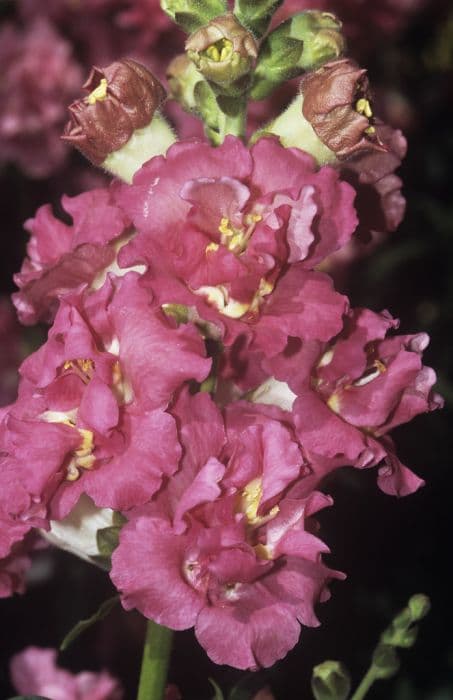Purple Toadflax Linaria purpurea 'Canon Went'

ABOUT
The Canon Went is a perennial flower known for its delicate and striking appearance. The plant features a multitude of slender, upright stems that are clothed in narrow, grayish-green leaves. The leaves are typically small and dense, forming a nice contrast to the flowers. The blossoms themselves are quite remarkable—they are shaped like miniature snapdragons, with an elongated, tubular structure that flares at the mouth into a two-lipped form. These flowers are a soft, pastel pink to mauve color, which gives the plant a gentle and sophisticated look. The flowers are densely packed in tall, slender spikes that rise elegantly above the foliage, creating a striking vertical element in the garden. The overall effect of the plant is one of airiness and grace, with the flowers seemingly floating above the narrow leaves, which gives the garden a whimsical and enchanted atmosphere.
About this plant
 Names
NamesFamily
Plantaginaceae
Synonyms
Purple Toadflax, Canon Went
Common names
Linaria purpurea 'Canon Went'.
 Toxicity
ToxicityTo humans
The common name for Linaria purpurea 'Canon Went' is Purple Toadflax. There is limited information available on the toxicity of Purple Toadflax to humans. It is not typically listed as a poisonous plant, and there might not be significant toxic effects associated with ingesting it. However, it is generally advised to avoid consuming parts of ornamental plants due to the potential for unknown toxicities or allergic reactions.
To pets
The common name for Linaria purpurea 'Canon Went' is Purple Toadflax. This plant is also not well-documented for toxicity in pets, such as cats and dogs. As with humans, it is not commonly listed among poisonous plants, but because comprehensive toxicological profiles for many plants are lacking, it is safest to prevent pets from ingesting Purple Toadflax. If a pet does ingest it and exhibits signs of distress such as vomiting, diarrhea, or unusual behavior, a veterinarian should be consulted.
 Characteristics
CharacteristicsLife cycle
Perennials
Foliage type
Deciduous
Color of leaves
Green
Flower color
Purple
Height
2-3 feet (60-90 cm)
Spread
1 foot (30 cm)
Plant type
Herb
Hardiness zones
5
Native area
Mediterranean
Benefits
 General Benefits
General Benefits- Attracts Pollinators: Linaria purpurea 'Canon Went', commonly known as Purple Toadflax, is known for attracting bees and butterflies, enhancing pollination in the garden.
- Drought Tolerance: This variety of Purple Toadflax is relatively drought-tolerant, making it suitable for dry or xeriscape gardens.
- Low Maintenance: It requires minimal care once established, making it an excellent choice for gardeners seeking low-maintenance plants.
- Long Blooming Period: Purple Toadflax has a long flowering season, typically from early summer to early fall, providing prolonged visual interest.
- Wildlife Friendly: The plant provides a habitat and food source for various insects, contributing to biodiversity in the garden.
- Easy to Grow: Purple Toadflax can thrive in a variety of soil types and does not require rich soil to flourish.
- Self-Seeding: This plant can self-seed under favorable conditions, ensuring its presence in the garden year after year without additional planting.
- Vertical Interest: With its tall spires of purple flowers, it adds vertical interest to garden borders and wildflower gardens.
- Versatile Design Element: Its delicate flowers and narrow leaves provide texture and color, making it a versatile plant for various garden designs.
- Herbaceous Perennial: As a perennial, it comes back every year, reducing the need for annual replanting.
 Medical Properties
Medical PropertiesThis plant is not used for medical purposes.
 Air-purifying Qualities
Air-purifying QualitiesThis plant is not specifically known for air purifying qualities.
 Other Uses
Other Uses- As a dye source: The flowers of the Linaria purpurea 'Canon Went', known as Purple Toadflax, can yield a yellow to green dye that can be used in fabric dyeing.
- Culinary garnish: The delicate flowers and leaves of the Purple Toadflax can be used as edible garnishes on salads and desserts.
- Photographic subject: The striking flowers of the Purple Toadflax make it a popular subject for garden photographers and botanical illustrators.
- Education and research: Purple Toadflax can be used in educational settings to teach about pollination and plant ecology.
- Erosion control: Its extensive root system can help stabilize soil in areas susceptible to erosion.
- Biodegradable ornaments: Dried stems and flowers of Purple Toadflax can be used in the creation of biodegradable crafts and ornaments.
- Floral art: The upright growth habit and colorful spikes of the Purple Toadflax make it suitable for inclusion in floral arrangements and bouquets.
- Indicator plant: It can be used by gardeners as an indicator plant to suggest soil conditions and health due to its sensitivity to soil types.
- Companion planting: Purple Toadflax can be planted strategically in the garden to attract beneficial insects that can help control pest populations.
- As a living fence: When planted in a dense row, Purple Toadflax can form a living barrier or informal border in a garden setting.
Interesting Facts
 Feng Shui
Feng ShuiThe plant Purple Toadflax is not used in Feng Shui practice.
 Zodiac Sign Compitability
Zodiac Sign CompitabilityThe plant Purple Toadflax is not used in astrology practice.
 Plant Symbolism
Plant Symbolism- Resilience: Linaria purpurea, commonly known as Toadflax, is a plant that thrives in challenging conditions, reflecting the ability to endure and persist.
- Humility: Its delicate appearance and modest size symbolize a sense of humility and unassuming grace.
- Simplicity: The simple beauty of the Toadflax's flowers represents an appreciation for the uncomplicated aspects of life.
- Protection: In folklore, Toadflax was sometimes associated with protective properties, suggesting the plant could ward off negative influences.
 Water
WaterThe Purple Toadflax needs to be watered deeply but infrequently; the aim is to encourage deep root growth. Once established, watering once a week with about 1 inch of water (which roughly translates to 0.6 gallons per square foot) is adequate. During hot or dry periods, increase the frequency to about twice a week, ensuring that the top inch of soil is moist but not soggy. It's important to reduce watering as the plant prepares for dormancy in the fall. Overwatering can lead to root rot, so ensure good drainage.
 Light
LightPurple Toadflax thrives best in full sun conditions, receiving at least six hours of direct sunlight daily. It can tolerate partial shade, especially in the hotter afternoons, but blooms best with ample sun. An east or south-facing location can provide the ideal light conditions, ensuring the healthiest growth and flowering.
 Temperature
TemperaturePurple Toadflax prefers temperatures that mimic its native Mediterranean climate, thrives in temperatures between 50°F and 70°F, can endure minimum temperatures down to 20°F, and maximum temperatures around 85°F. However, extreme heat or frost can stress the plant, so it's best grown in temperatures that remain within this ideal range.
 Pruning
PruningPruning Purple Toadflax promotes bushier growth and better flowering. Light pruning can be done in early spring to shape the plant and remove any winter damage. It's also beneficial to deadhead spent flowers to encourage continuous blooming. Prune more extensively after the main bloom period, typically in late summer or early fall, to rejuvenate the plant and prepare it for the next growing season.
 Cleaning
CleaningAs needed
 Soil
SoilToadflax (Linaria purpurea 'Canon Went') thrives best in well-draining, loamy or sandy soil with moderate fertility. The ideal pH range for this plant is neutral to slightly alkaline, between 6.5 to 7.5. An optimum soil mix can be achieved by combining garden soil with sand and peat or compost to enhance drainage and provide sufficient nutrients.
 Repotting
RepottingToadflax plants, including the 'Canon Went' variety, do not usually require frequent repotting as they are often treated as annuals or biennials. If growing as perennials, repotting every 2-3 years in fresh soil may be beneficial to replenish nutrients and encourage growth.
 Humidity & Misting
Humidity & MistingToadflax (Linaria purpurea 'Canon Went') is not highly sensitive to humidity and can tolerate a wide range. It typically thrives in the average humidity levels found in outdoor environments without any special requirements.
 Suitable locations
Suitable locationsIndoor
Place Toadflax in bright, indirect light with some direct sun.
Outdoor
Grow in full sun to partial shade, in well-drained soil.
Hardiness zone
5-9 USDA
 Life cycle
Life cycleLinaria purpurea 'Canon Went', commonly known as Purple Toadflax, begins its life cycle as a seed germinating in late winter to early spring. Upon germination, the seedlings develop into rosettes of narrow, green leaves. As the plant matures, it sends up tall, erect stems in late spring to early summer, which will boast dense spikes of small, snapdragon-like purple-pink flowers. Pollinators such as bees and butterflies visit the flowers, leading to cross-pollination. Following flowering, which may continue throughout summer into early autumn, seed capsules form and eventually release their seed to the environment. The plant may die back in winter, especially in colder climates, but it is a perennial and will regrow from its rootstock when conditions become favorable in the spring.
 Propogation
PropogationPropogation time
Spring to Summer
The most popular method for propagating Linaria purpurea 'Canon Went', commonly known as Purple Toadflax, is through seed. The ideal time for sowing the seeds is in spring, after the last frost, when soil temperatures have adequately warmed. To propagate, seeds should be sown thinly on top of well-draining soil and lightly covered with a fine layer of soil or compost as they require light to germinate. It's important to keep the soil consistently moist but not waterlogged. Seeds typically germinate in 14 to 21 days at a temperature around 70 degrees Fahrenheit (21 degrees Celsius). Once seedlings have grown large enough to handle, they can be thinned out to prevent overcrowding and transplanted to their final positions in the garden.





![Snapdragon [Pretty in Pink]](/_next/image?url=https%3A%2F%2Fplants-admin.emdemapps.com%2Fimages%2Fplants%2F%2Fimages%2F604b5cb3b5385.png&w=640&q=75)



